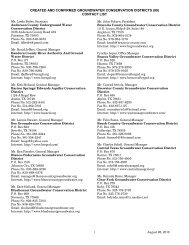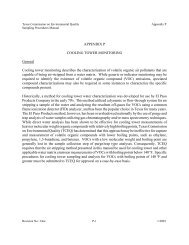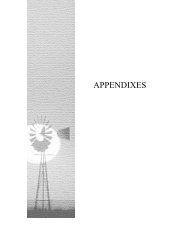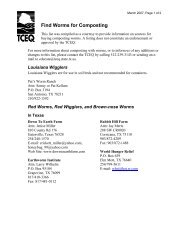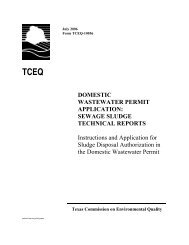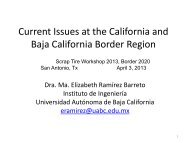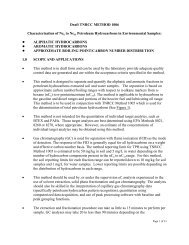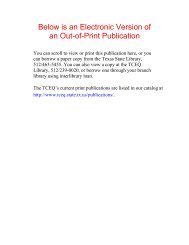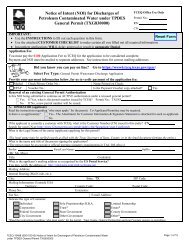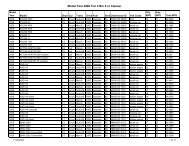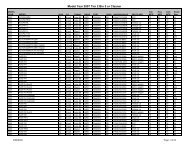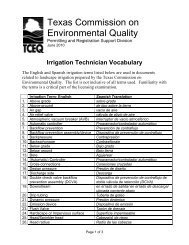the <strong>on</strong>ly chipmunk in <str<strong>on</strong>g>Texas</str<strong>on</strong>g>, the gray-footed chipmunk (Tamias canipes), are protected within GuadalupeMountains Nati<strong>on</strong>al Park. Elk (Cervus elaphus) were introduced in the 1920’s to replace an extinct subspecies,the Merriam elk, which was known in the regi<strong>on</strong> <strong>on</strong>ly from archeological evidence. The elk introducti<strong>on</strong> wasnot without some c<strong>on</strong>troversy. In a report describing the benefits <str<strong>on</strong>g>of</str<strong>on</strong>g> adding the McKittrick Cany<strong>on</strong> area to theNati<strong>on</strong>al Park System, Wright et al., (1932) observed that the Rocky Mountain elk were an exotic additi<strong>on</strong> tothe desert landscape, that they would c<strong>on</strong>centrate their activities in the limited riparian habitats, and have anegative impact <strong>on</strong> the native vegetati<strong>on</strong>. The report recommended that the elk be greatly reduced in numberor extirpated entirely if the area were to become a Nati<strong>on</strong>al Park. The elk populati<strong>on</strong> increased to 350 by themid 1960’s, but since then they have declined steadily to their original numbers (Schmidley 2002). Anotherintroduced mammal, the aoudad (Barbary sheep) (Ammotragus lervia), has taken over the ecological niche<strong>on</strong>ce occupied by desert bighorn sheep (Ovis canadensis), which had been eliminated from the GuadalupeMountains by 1910 (<str<strong>on</strong>g>Texas</str<strong>on</strong>g> State Historical Associati<strong>on</strong> 2002).Level IV Ecoregi<strong>on</strong>23b. M<strong>on</strong>tane WoodlandArea (sq. mi.) 16PhysiographyFault block mountain range dissected by deep cany<strong>on</strong>s; Moderate gradientintermittent, flashy streams with mostly cobble, gravel, and sandy substrates.Elevati<strong>on</strong> /Local Relief (feet)5,000-8000 /400-1200Pleistocene to Holocene clay loam colluvium mixed with limest<strong>on</strong>e and sandst<strong>on</strong>eSurficial Geology;fragments, gypsum deposits; Pleistocene to Holocene gravels and sands in drainages.Bedrock GeologyPermian limest<strong>on</strong>es, sandst<strong>on</strong>es, and clayst<strong>on</strong>es.Soil Order (Great Groups) Mollisols (Calciustolls)Comm<strong>on</strong> Soil SeriesDeama, Rock outcrop.Soil Temperature /Soil Moisture RegimesMesic /UsticMean Annual Precipitati<strong>on</strong> (in.) 18-22Mean Annual Frost Free Days 110-170Mean Temperature (F)(Jan. min/max; July min/max)Vegetati<strong>on</strong>Land Cover and Land Use29/52;62/85North-facing cany<strong>on</strong> slopes and upland locati<strong>on</strong>s above 7000 feet: P<strong>on</strong>derosapine, southwestern white pine, Douglas-fir, limited aspen <strong>on</strong> talus slopes. M<strong>on</strong>tanewoodland: piny<strong>on</strong> pine, red-berry juniper, gray oak, Emory oak. M<strong>on</strong>tane grassland:little bluestem, gramas, needlegrasses. Cany<strong>on</strong> riparian woodland: chinkapin oak,alligator juniper, bigtooth maple, <str<strong>on</strong>g>Texas</str<strong>on</strong>g> madr<strong>on</strong>e, velvet ash.Patches <str<strong>on</strong>g>of</str<strong>on</strong>g> m<strong>on</strong>tane woodland, grassland, riparian woodland. Public land (GuadalupeMountains Nati<strong>on</strong>al Park), recreati<strong>on</strong>, research.Guadalupe Mountains Nati<strong>on</strong>al Park is <strong>on</strong>e<str<strong>on</strong>g>of</str<strong>on</strong>g> the few areas in <str<strong>on</strong>g>Texas</str<strong>on</strong>g> where the cougarhas protected status. However, even withunregulated hunting pressure outside the park,cougars are well-established in <str<strong>on</strong>g>Ecoregi<strong>on</strong>s</str<strong>on</strong>g> 23and 24. Photo: US Fish and Wildlife ServiceCany<strong>on</strong> vegetati<strong>on</strong> includes juniper, ash, oak, <str<strong>on</strong>g>Texas</str<strong>on</strong>g> madr<strong>on</strong>e, and bigtoothmaple, with some p<strong>on</strong>derosa pine at higher elevati<strong>on</strong>s. Mule deer and elktend to c<strong>on</strong>centrate in riparian areas, stripping the bark <str<strong>on</strong>g>of</str<strong>on</strong>g>f older trees andc<strong>on</strong>suming emerging seedlings. The <str<strong>on</strong>g>Texas</str<strong>on</strong>g> madr<strong>on</strong>e is particularly vulnerableto browsing pressure. Photo: George Hosek<str<strong>on</strong>g>Ecoregi<strong>on</strong>s</str<strong>on</strong>g> <str<strong>on</strong>g>of</str<strong>on</strong>g> <str<strong>on</strong>g>Texas</str<strong>on</strong>g> 7
24 Chihuahuan DesertsThis desert ecoregi<strong>on</strong> extends from the Madrean Archipelago (79) in southeastern Ariz<strong>on</strong>a to the EdwardsPlateau (30) in south-central <str<strong>on</strong>g>Texas</str<strong>on</strong>g>. It is the northern porti<strong>on</strong> <str<strong>on</strong>g>of</str<strong>on</strong>g> the southernmost desert in North Americathat extends more than 500 miles south into Mexico. In much <str<strong>on</strong>g>of</str<strong>on</strong>g> the U.S. porti<strong>on</strong>, the physiography <str<strong>on</strong>g>of</str<strong>on</strong>g> theregi<strong>on</strong> is generally a c<strong>on</strong>tinuati<strong>on</strong> <str<strong>on</strong>g>of</str<strong>on</strong>g> basin and range terrain (excluding the Stockt<strong>on</strong> Plateau) that is typical<str<strong>on</strong>g>of</str<strong>on</strong>g> the Mojave Basin and Range (14) and the Central Basin and Range (13) ecoregi<strong>on</strong>s to the west and north,although the pattern <str<strong>on</strong>g>of</str<strong>on</strong>g> alternating mountains and valleys is not as pr<strong>on</strong>ounced as it is in <str<strong>on</strong>g>Ecoregi<strong>on</strong>s</str<strong>on</strong>g> 13 and 14.The mountain ranges are a geologic mix <str<strong>on</strong>g>of</str<strong>on</strong>g> faulted limest<strong>on</strong>e reefs, volcanoes and associated basalt and tuffextrusive rocks, and rhyolitic intrusi<strong>on</strong>s. Outside the major river drainages, such as the Rio Grande and PecosRiver, the landscape is largely internally drained. Vegetative cover is predominantly semi-desert grasslandand arid shrubland, except for high elevati<strong>on</strong> islands <str<strong>on</strong>g>of</str<strong>on</strong>g> oak, juniper, and piny<strong>on</strong> pine woodland. The extent<str<strong>on</strong>g>of</str<strong>on</strong>g> desert shrubland is increasing across lowlands and mountain foothills due to gradual desertificati<strong>on</strong> causedin part by historical grazing pressure.24a Chihuahuan Basins and PlayasThe boundaries for the Chihuahuan Basins and Playas ecoregi<strong>on</strong> surround areas <str<strong>on</strong>g>of</str<strong>on</strong>g>lowest elevati<strong>on</strong> in west <str<strong>on</strong>g>Texas</str<strong>on</strong>g> (under 1500 feet near the c<strong>on</strong>fluence <str<strong>on</strong>g>of</str<strong>on</strong>g> the Pecos andRio Grande rivers), alluvial basins near these rivers, and arid intermountain basins andsalt flats under 4500 feet. The boundaries <str<strong>on</strong>g>of</str<strong>on</strong>g> these disjunct areas are marked climaticallyby rainfall amounts between 8 and 14 inches, the lowest in the state, by soils that arealkaline or gypsiferous, and by desert shrub vegetati<strong>on</strong>, predominantly creosote bush.The major Chihuahuan basins in Ecoregi<strong>on</strong> 24a, such as the Hueco, Salt, and Presidio basins, formedduring the Basin and Range tect<strong>on</strong>ism when the earth’s crust stretched, causing porti<strong>on</strong>s <str<strong>on</strong>g>of</str<strong>on</strong>g> the crust to collapsecreating deep depressi<strong>on</strong>s or grabens that filled with sediment over time. The sediments c<strong>on</strong>sist <str<strong>on</strong>g>of</str<strong>on</strong>g> clay, silt,sand, and gravel up to 9000 feet thick (such as in the Hueco basin) (Spearing <str<strong>on</strong>g>199</str<strong>on</strong>g>1). The flat arid floors <str<strong>on</strong>g>of</str<strong>on</strong>g>these basins (playas) have saline or alkaline soils and areas <str<strong>on</strong>g>of</str<strong>on</strong>g> white salt flats (former lake beds), dunes, andwindblown sand. Surrounding the playas at low elevati<strong>on</strong>s are miles <str<strong>on</strong>g>of</str<strong>on</strong>g> desert shrubland. These basins <str<strong>on</strong>g>of</str<strong>on</strong>g>tenlie in the rainshadow <str<strong>on</strong>g>of</str<strong>on</strong>g> nearby mountain ranges; they represent the hottest and driest habitats in <str<strong>on</strong>g>Texas</str<strong>on</strong>g>, withless than 14 inches <str<strong>on</strong>g>of</str<strong>on</strong>g> precipitati<strong>on</strong> per year. Winter precipitati<strong>on</strong> is relatively sparse; precipitati<strong>on</strong> amountsare highest during the m<strong>on</strong>so<strong>on</strong>al rains <str<strong>on</strong>g>of</str<strong>on</strong>g> July, August, and September.The desert flora must withstand large diurnal ranges in temperature, low available moisture, and anextremely high evapotranspirati<strong>on</strong> rate. The highly saline porti<strong>on</strong> <str<strong>on</strong>g>of</str<strong>on</strong>g> the playas at the lowest elevati<strong>on</strong>s, maybe completely barren, but salt-tolerant plants such as fourwing saltbush (Atriplex canescens), pickleweed(Allenrolfea occidentalis), and alkali sacat<strong>on</strong>(Sporobolus airoides) do grow in the margins<str<strong>on</strong>g>of</str<strong>on</strong>g> the dry lake beds where the water table isnear the surface (Bezans<strong>on</strong> 2000). The valleysand rolling alluvial fans above the basin floorssupport vast areas <str<strong>on</strong>g>of</str<strong>on</strong>g> desert shrubs dominatedby creosote bush (Larrea tridentata) andtarbush (Flourensia cernua). Land use forgrazing has evolved from cattle to sheepand goats as the range has changed from apredominance <str<strong>on</strong>g>of</str<strong>on</strong>g> grass to desert shrubs.Creosote bushes grow <strong>on</strong> alkaline flats in evenly spaced rows with theirpositi<strong>on</strong>s relative to <strong>on</strong>e another determined by water availability. Theseshrubs are also allelopathic, meaning they release toxins into the surroundingsoil that discourage competiti<strong>on</strong> from neighboring plants. Photo: Sandy BryceThe low elevati<strong>on</strong> desert country <str<strong>on</strong>g>of</str<strong>on</strong>g> thePecos River basin and the Rio Grande Riverbasin bound West <str<strong>on</strong>g>Texas</str<strong>on</strong>g> <strong>on</strong> the east, south,and west. Both rivers carry water into theregi<strong>on</strong> from sources in the Rocky Mountains8<str<strong>on</strong>g>Ecoregi<strong>on</strong>s</str<strong>on</strong>g> <str<strong>on</strong>g>of</str<strong>on</strong>g> <str<strong>on</strong>g>Texas</str<strong>on</strong>g>
- Page 1: Below is an Electronic Version <str
- Page 4 and 5: ECOREGIONS OF TEXAS</strong
- Page 6 and 7: TABLE OF CONTENTSABSTRACT..........
- Page 8 and 9: 2526272526272330293235332430323423
- Page 10 and 11: INTRODUCTIONSpatial frameworks are
- Page 12 and 13: Maps of environmen
- Page 14 and 15: vegetation or small areas o
- Page 18 and 19: to the north. There is a high deman
- Page 20 and 21: taller, coarser tobosa grass (Pleur
- Page 22 and 23: the fractured rock. The Bof
- Page 24 and 25: hollows, moving upslope to create c
- Page 26 and 27: The headwater catfish (Ictalurus lu
- Page 28 and 29: streams. Two sand plains streams, C
- Page 30 and 31: Several caliche horizons (calcium c
- Page 32 and 33: winds (Spearing 199</strong
- Page 34 and 35: Geology is an important geographica
- Page 36 and 37: the villages of Pa
- Page 38 and 39: Area (sq. mi.) 5569PhysiographyFlat
- Page 40 and 41: Tableland topography of</st
- Page 42: y the Brazos and Colorado rivers ha
- Page 45 and 46: Level IV Ecoregion27i. Broken Red P
- Page 47 and 48: Post oaks (Quercus stellata) and bl
- Page 49 and 50: Level IV Ecoregion29c. Western Cros
- Page 51 and 52: than the limestone of</stro
- Page 53 and 54: underlying the sandstone. This has
- Page 55 and 56: Since settlement, many wildlife spe
- Page 57 and 58: (Pellaeae spp.), Nuttall’s stonec
- Page 59 and 60: Trinity-Edwards aquifer, discharges
- Page 61 and 62: Edwards Plateau to savanna-like con
- Page 63 and 64: species list, prefers fast moving w
- Page 65 and 66: Level IV Ecoregion31a. Northern Nue
- Page 67 and 68:
31c Texas-Tamaulip
- Page 69 and 70:
31d Rio Grande Floodplain and Terra
- Page 71 and 72:
62shrink when dry and swell when we
- Page 73 and 74:
32b Southern Blackland PrairieThe S
- Page 75 and 76:
33 EAST CENTRAL TE
- Page 77 and 78:
and need some patchy distubances an
- Page 79 and 80:
33d Northern Prairie OutliersThe sm
- Page 81 and 82:
Level IV Ecoregion33e. Bastrop Lost
- Page 83 and 84:
34a Northern Humid Gulf Coastal Pra
- Page 85 and 86:
34b Southern Subhumid Gulf Coastal
- Page 87 and 88:
occasional discontinuous drainage r
- Page 89 and 90:
oundary was the ability to match th
- Page 91 and 92:
Level IV Ecoregion34f. Lower Rio Gr
- Page 93 and 94:
live oak trees (Quercus virginiana)
- Page 95 and 96:
Shoal grass (Halodule wrightii) mea
- Page 97 and 98:
Upland oak-pine forest in Ecoregion
- Page 99 and 100:
35c Pleistocene Fluvial TerracesThe
- Page 101 and 102:
35f FlatwoodsMostly flat to gently
- Page 103 and 104:
pasture, although some woodland sti
- Page 105 and 106:
invariant definition of</st
- Page 107 and 108:
how many stream sites/watersheds ar
- Page 109 and 110:
commonly believed. Typically, about
- Page 111 and 112:
CONCLUSIONS AND RECOMMENDATIONSThis
- Page 113 and 114:
104Ecoregions <str
- Page 115 and 116:
Biggs, B.J.F., M.J. Duncan, I.G. Jo
- Page 117 and 118:
Diggs, G.M., Jr., and P.C. Schulze.
- Page 119 and 120:
Graves, J. 2002. Texas</str
- Page 121 and 122:
Hunt, C.B. 1967. Physiography <stro
- Page 123 and 124:
Maxwell, T.C. 1979. Avifauna <stron
- Page 125 and 126:
Richmond, G.M., D.L. Weide, and D.W
- Page 127 and 128:
U.S. Department of
- Page 129 and 130:
Woods, A.J., J.M. Omernik, D.R. But
- Page 131 and 132:
Herbaceous Plants(Forbs, Grasses, a
- Page 133 and 134:
Hickory, BlackHickory, WaterHollyHu



